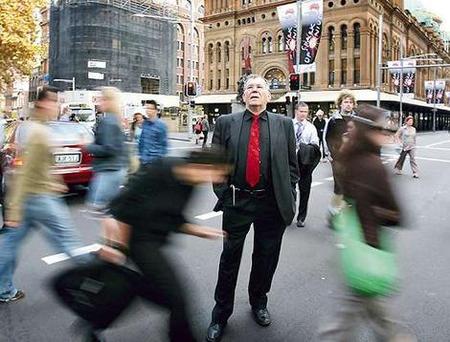http://www.gardenvisit.com/blog/wp-content/uploads/2012/03/jan_gehl.jpg
Our time and experience of the world is subject to many different variables; perceptions, ideologies, upbringing, culture, et al., the list is almost endless. An example of this would be going to a cultural event and seeing many different types of cultures exhibited, all varying, and different in their own ways, but in many ways they are similar, why? There are plenty of examples in religion where their base code of ethics and morals come down to what Abrahamic religions cast in the 10 Commandments, those being things like not murdering, not stealing, etc. These rules can be seen in many other cultures, which is indicative of the intertwined relationship humans and cultures have had in the past, especially in the ancient melting pots of Asia Minor and North Africa.
Much of people's perceptions of other things are down to the mode in which they are taught to look at these particular things. Maps for example. Western cultures tends towards cartography to explain their view of the world, as do other cultures, some however do not, they are verbal cultures. Tuan wrote 'the main reason we neglect speech is because we tend to see place as a material transformation of nature'. Indigenous Australian culture is an example of a strictly verbal culture "even fairy tales reflect ways of seeing and knowing the world" (Kuttainen, 2015). Many traditional communities still follow the practises of old which include verbal storytelling. In western society we are taught to trust what is written down more than what is spoken from the mouth, perhaps because what is written down is more difficult to change, but that's entirely dependent on the person who wrote it to begin with.
References
Tuan, Y. (1991). Language and the Making of Place: A Narrative-Descriptive Approach. Annals of the Association of American Geographers.
Kuttainen, V. (2015). BA1002: Our Space: Networks, Narratives, and the Making of Place, Lecture 5: Stories and Places [PowerPoint Slides]. Retrieved from http://learnjcu.edu.au

In relation to your post where you stated that “In western society we are taught to trust what is written down more than what is spoken from the mouth” (Henden, 2015) this statement is not necessarily true. It does give some truth when it comes to questioning and always searching for all the sides of the story before making an opinion. However, in western society and in my personal experience. We are taught not to believe absolutely everything we read, as most of what is written is only half of what actually happened and is written to the bias and perspective of the person who wrote it.
ReplyDeleteReference
Netsafe.org.nz,. (2015). Young People - Dont believe everything you see, read or hear online - netsafe.org.nz. Retrieved 21 September 2015, from http://www.netsafe.org.nz/keeping_safe.php?pageID=245§ionID=young&menuID=67#modal-text
In relation to your post where you stated that “In western society we are taught to trust what is written down more than what is spoken from the mouth” (Henden, 2015) this statement is not necessarily true. It does give some truth when it comes to questioning and always searching for all the sides of the story before making an opinion. However, in western society and in my personal experience. We are taught not to believe absolutely everything we read, as most of what is written is only half of what actually happened and is written to the bias and perspective of the person who wrote it.
ReplyDeleteReference
Netsafe.org.nz,. (2015). Young People - Dont believe everything you see, read or hear online - netsafe.org.nz. Retrieved 21 September 2015, from http://www.netsafe.org.nz/keeping_safe.php?pageID=245§ionID=young&menuID=67#modal-text